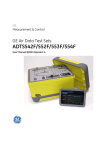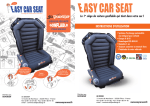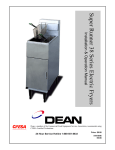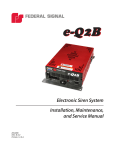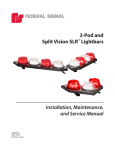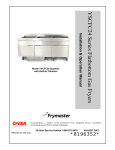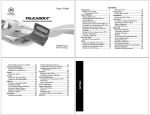Download Dean TC25 Specifications
Transcript
Triathlon Series Gas Fryers Installation & Operation Manual Models TC25 & TC35 Dean, a member of the Commercial Food Equipment Service Association, recommends using CFESA Certified Technicians. 24-Hour Service Hotline 1-800-551-8633 Price: $6.00 819-5683 10-98 PLEASE READ ALL SECTIONS OF THIS MANUAL AND RETAIN FOR FUTURE REFERENCE. THIS PRODUCT HAS BEEN CERTIFIED AS COMMERCIAL COOKING EQUIPMENT AND MUST BE INSTALLED BY PROFESSIONAL PERSONNEL AS SPECIFIED. WE SUGGEST INSTALLATION, MAINTENANCE AND REPAIRS SHOULD BE PERFORMED BY YOUR DEAN FACTORY AUTHORIZED SERVICE AGENCY. FOR YOUR SAFETY, INSTRUCTIONS TO BE FOLLOWED IN CASE THE USER SMELLS GAS ARE TO BE POSTED IN A PROMINENT LOCATION. THIS INFORMATION SHALL BE OBTAINED BY CONTACTING THE LOCAL GAS COMPANY OR GAS SUPPLIER. FOR YOUR SAFETY, DO NOT STORE OR USE GASOLINE OR OTHER FLAMMABLE VAPORS AND LIQUIDS IN THE VICINITY OF THIS OR ANY OTHER GAS APPLIANCE. IMPORTANT SAFE AND SATISFACTORY OPERATION OF YOUR EQUIPMENT DEPENDS ON ITS PROPER INSTALLATION. INSTALLATION MUST CONFORM WITH LOCAL CODES, OR IN ABSENCE OF LOCAL CODES, WITH THE NATIONAL FUEL GAS CODE, ANSI Z223.1; THE NATURAL GAS INSTALLATION CODE, CAN/CGA-B149.1; OR THE PROPANE INSTALLATION CODE, CAN/CGA-B149.2. COVER PHOTO Triathlon Series Model TC-35 Countertop Gas Fryer TRIATHLON SERIES GAS FRYERS INSTALLATION AND OPERATION MANUAL TABLE OF CONTENTS 1. 2. 3. 4. 5. 6. 7. PARTS ORDERING AND SERVICE INFORMATION IMPORTANT INFORMATION INSTALLATION DAILY OPERATION CLEANING AND MAINTENANCE TROUBLESHOOTING (TC 25 and TC 35 Millivolt Systems) COMPONENT LISTING AND INSTALLATION STANDARDS PAGE 2 3 5 10 12 13 16 1. PARTS ORDERING AND SERVICE INFORMATION 1.1 ORDERING PARTS: 1.2 SERVICE INFORMATION: Customers may order parts directly from their local Authorized Parts Distributor. For this address and phone number, contact your Maintenance & Repair Center or call the factory. The factory address and phone numbers are on the cover of this manual. Call the “800” number on the cover of this manual for the location of your nearest Maintenance & Repair Center or contact the factory direct. Always give the model and serial number of your fryer. To assist you more efficiently, the following information will be needed: To speed up your order, the following information is required: Model Number Type Serial Number Type of Gas Optional Equipment Nature of Problem Any other information which may be helpful in solving your service problem. Model Number Type Serial Number Type of Gas Item Part Number Quantity Needed 2 2. IMPORTANT INFORMATION 2. The Triathlon TC-25 gas fryers have millivolt controls which do not require electrical power connections and do not have an ON/OFF switch on the control panel. 2.1 DESCRIPTION: The Dean Triathlon TC-series “Cool Zone” tube gas fryers are energy-efficient, gas-fired units, designcertified by the International Approval Services (AGA/CGA) and NSF International and manufactured to their basic performance and application specifications. 3. The Triathlon TC-35 gas fryers are equipped with millivolt controls or the optional 120-volt solid state temperature controller and 120-volt gas solenoid valve. 120-volt systems have an ON/OFF power switch on the control panel. All units are shipped completely assembled with accessories packed inside the fryer vessel. All units are adjusted, tested and inspected at the factory before shipment. Sizes, weights and input rates of all models are listed in this manual. b. CLEARANCES: The fryer area must be kept free and clear of all combustibles. This unit is designcertified for the following installations: NOTE: The on-site supervisor is responsible for ensuring that operators are made aware of inherent dangers of operating a deep fat fryer, particularly aspects of oil filtration, draining, and cleaning of the fryer. 1. Other than household use; 2. Installation on a non-combustible platform when equipped with factory-supplied 4” (10.2 cm) adjustable legs; 2.2 RATING PLATE: This is attached to 3. With a minimum clearance of 0” side and 0” rear of non-combustible construction; and a minimum clearance of 6” (15 cm) at both side and rear for combustible materials. the lower corner of the left side panel. Information provided includes the model number, serial number, BTU/hr input of the burners, outlet gas pressure in inches WC, electrical requirements, and whether the unit has natural or propane gas orifices. d. U.S. installations must meet: American National Standard Institute ANSI Z223.1, Z-83.13, & Z83.14 American Gas Association 8501 E. Pleasant Valley Road Cleveland, OH 44131 DANGER THE FRYER MUST BE CONNECTED ONLY TO THE TYPE OF GAS IDENTIFIED ON THE ATTACHED RATING PLATE. a. GENERAL: Only a licensed plumber should install any gas-fired equipment. National Electrical Code ANSI/NFPA #70 American National Standard Institute 1430 Broadway New York, NY 10018 1. A manual gas shut-off valve must be installed in the gas supply line ahead of the fryer(s) for safety and ease of future service. NFPA Standards #96 and #211 National Fire Protection Association 470 Atlantic Avenue Boston, MA 02110 2.3 PRE-INSTALLATION: 3 e. Canadian installations must meet: e. Exhaust temperatures, in addition to the open tank of hot oil make the storage of anything on shelving over or behind the fryer unsafe. Canadian Electric Code c22.1, part 1 Canadian Standards Association 178 Rexdale Blvd. Rexdale, ONT, M9W 1R3 f. Filters and drip troughs should be part of any industrial hood, but consult local codes before constructing and installing any hood. The duct system, the exhaust hood and the filter bank must be cleaned on a regular basis and kept free of grease. CAN/CGA Installation Codes: B149.1 (Natural Gas) B149.2 (Propane) Canadian Gas Association 55 Scarsdale Road Don Mills, ONT, M3B 2R3 2.5 ALTITUDE: The fryer input rating (BTU/hr) is for elevations up to 2,000 feet (610 m). For elevations above 2,000 feet, the rating should be reduced four percent (4%) for each additional 1,000 feet (305 m) above sea level. For example: 3,000 feet (915 m) must be reduce by 12%. 2.4 AIR SUPPLY & VENTILATION: Keep the area around the fryer clear to prevent obstruction of combustion and ventilation air flow as well as for service and maintenance. Never use the interior of the fryer’s cabinet for storage. The correct orifices are installed at the factory if operating altitude is known at time of the customer’s order. a. A commercial, heavy-duty fryer must vent its combustion wastes to the outside of the building. It is essential that a deep fat fryer be set under a powered exhaust hood or that an exhaust fan be provided in the wall above the unit, as exhaust gas temperatures are approximately 500900°F (260-482°C). Check air movement during installation. Strong exhaust fans in this hood or in the overall air conditioning system can produce slight air drafts in the room. 2.6 RECEIVING AND UNPACKING: Check that the container is upright. Use outward prying only— no hammering— to remove the carton. Check the fryer(s) for visible damage, if damage has occurred, do not refuse shipment, but contact the appropriate freight claims. Do not contact the factory, as the responsibility for shipping damage is between the carrier and the dealer or end-user. b. Do not place the fryer’s flue outlet directly into the plenum of the hood, as it will affect the gas combustion of the fryer. Remove, unwrap, wash, and temporarily set aside any accessories shipped in the fryer vessel. c. Do not store anything on shelving over or behind the fryer. d. Adequate distance must be maintained from the flue outlet of the fryer(s) to the lower edge of the filter bank. NFPA Standard No. 96 states that “a minimum of 18 inches (45 cm)” should be maintained between the flue(s) and the lower edge of the exhaust hood filter. 4 3. INSTALLATION can occur because the bottom hex nut has been turned too far and may come off. 3.1 LEGS: Legs are installed at the factory. They are firmly tightened to the frame to keep the unit from tilting, thus preventing any undue strain to the legs and internal mounting hardware. After unpacking, it is strongly recommended to check the legs to make sure they are still firmly tightened. c. If the platform is uneven or has a decided slope, a smooth platform is recommended for placing the unit on and not relying on leg thread adjustment. 3.2 POSITIONING: d. After each move, as the fryer may not return exactly to its previous position after being moved, re-level the fryer as stated above. a. Relocating The Fryer: Remove all weight from each leg before moving. b. If a leg becomes damaged during movement, contact your service agent for immediate repair/replacement of that leg. 3.4 GAS CONNECTIONS: The gas supply (service) line must be the same size or greater than the fryer inlet line. This fryer uses a ¾” NPT inlet; however, the gas supply lines must be sized to accommodate all the gas-fired equipment that may be connected to that gas supply. Consult your contractor, gas company, supplier, or other knowledgeable authorities. CAUTION THIS FRYER MAY TIP AND CAUSE PERSONAL INJURY IF NOT SECURED IN A STATIONARY POSITION. REMOVE ALL SHORTENING BEFORE MOVING FRYER AS IT MAY CAUSE SEVERE BURNS UPON CONTACT. a. Manual shut-off valve: This gas service supplier-installed valve must be installed in the gas service line ahead of the fryer in the gas stream and in a position where it can be reached quickly in the event of an emergency. 3.3 LEVELING: a. Place a carpenter’s spirit level across the top of the fryer and level the unit both front-to-back and side-to-side. If it is not level, the unit may not function efficiently, the oil may not drain properly for filtering and in a line-up it may not match adjacent units. b. Pressure regulating: 1. External regulators are not normally required on this fryer, as a safety combination gas control valve performs that function. b. If the platform is smooth and level, level the unit by using the leg screw threads; adjust to the high corner and measure with the spirit level. The legs have about one inch of adjustment thread. When leveling the unit, the leg body should be held firmly to keep the leg from rotating while turning the 5/8” bottom leg hex nut counterclockwise. Turn the hex nut to adjust to required height. 2. If the incoming pressure is in excess of ½” PSIG (3.45 KPa), a step-down regulator will be required. Your local servicer should check the manifold pressure with a manometer. Natural gas units require 3.5” WC (8.71mbar) and propane requires 10” WC (25mbar). If adjustment exceeds one inch, the unit will become unstable and tipping 5 CAUTION 2. Any installed quick-disconnect devices must comply with the Standard for Quick Disconnect Devices for Use with Gas Fuel, ANSI Z21.41, or Quick Disconnect for Use with Gas Fuel, CAN 1-6.9, Adequate means must be provided to prevent the movement of the appliance without depending on the connector and the quick disconnect device or its associated piping to prevent the appliance movement. THE FRYER MUST BE ISOLATED FROM THE GAS SUPPLY PIPING SYSTEM BY CLOSING ITS INDIVIDUAL, MANUAL SHUT-OFF VALVE DURING ANY PRESSURE TESTING OF THE GAS SUPPLY PIPING SYSTEM AT PRESSURES EQUAL TO OR LESS THAN ½ PSIG (3.45 KPa). c. Orifices: The fryer can be connected to either natural or propane gas. The correct safety control valve and appropriate gas orifices are installed at the factory. While the valve can be adjusted in the field, only qualified service personnel should make any adjustments with the proper test equipment. 3. The fryer may tip and cause personal injury if not secured in a stationary position. If the fryer is mounted on a table, the fryer must be attached to that table. The table should have a restraining device to prevent movement. d. Rigid Connections: The fryer can be connected singularly or as part of a cooking line. Check any installersupplied intake pipe(s) visually and clean threading chips, or any other foreign matter before installing into a service line. If the intake pipes are not clear of all foreign matter, the orifices will clog when gas pressure is applied. 3.5 ELECTRICAL CONNECTIONS: The wiring diagram is attached to the inside of the fryer door. The diagram can also be found in Chapter 6, Troubleshooting Guide. The fryer is equipped with a millivolt control system which does not need an outside power source. CAUTION ALL CONNECTIONS MUST BE SEALED WITH A JOINT COMPOUND SUITABLE FOR LP GAS, AND ALL CONNECTIONS MUST BE TESTED WITH A SOAPY SOLUTION BEFORE LIGHTING ANY PILOTS. WARNING PUTTING AN OPEN FLAME BESIDE A NEW CONNECTION IS NOT ONLY DANGEROUS, BUT WILL OFTEN MISS SMALL LEAKS THAT A SOAPY SOLUTION WILL FIND. e. Flexible Couplings & Connectors: 3.6 INITIAL START-UP: 1. If the unit is installed with couplings or quick disconnect fittings, the installer must use a heavy-duty, AGA design-certified commercial connector of at least ¾” NPT (with suitable strain relief) in compliance with ANSI Z-21.691979. Domestic connectors are not suitable. a. CLEANING: New units are wiped clean with solvents at the factory to remove any visible signs of dirt, oil, grease, etc. remaining from the manufacturing process, then coated lightly with oil. Wash thoroughly with hot, soapy water to remove any film residue and dust or debris before food preparation, then rinse out and wipe 6 dry. Wash also any accessories shipped with the unit. Close the drain-valve completely and remove the crumb screen. Make sure the screws holding the thermostat and limit control sensing bulbs into the vessel are tight. WARNING WHEN LIGHTING PILOTS AND CHECKING FOR BURNER PERFORMANCE, DO NOT STAND WITH YOUR FACE CLOSE TO THE BURNERS… THEY MAY LIGHT WITH A “POP” AND COULD CAUSE FLASH BACK AND FACIAL BURNS. Drain Valve Handle Fry Vessel Drain b. INITIAL PILOT LIGHT: All Dean Industries’ fryers are tested, adjusted and calibrated to sea level conditions before leaving the factory. Adjustments to assure proper operation may be necessary on installation to meet local conditions, low gas pressure, differences in altitude, variations in gas characteristics, to correct possible problems caused by rough handling or vibration during shipment, and are to be performed only by qualified service personnel. These are the responsibility of the customer and/or dealer and are not covered by Dean Industries’warranty. Location of Pilot 2. TC-25/TC-35 Millivolt Systems: Ensure that the following steps are done in sequence before lighting or re-lighting the pilot: a) Turn off the manual shut-off valve on the incoming service line. b) Turn the operating thermostat “OFF”. c) Depress the pilot gas cock dial on the safety control valve and turn “OFF”. 1. The inlet pipe at the lower rear of the fryer brings incoming gas to the pilot safety control valve, then to the pilot and/or main burners. The pilot is located high in the cabinet center, at the base of the fryer vessel. It will require a long match or taper to light. Pilot Gas Cock Knob 7 3. TC-35 Optional 120-Volt Solid State Controller System: Ensure that the following steps are done in sequence before lighting or re-lighting the pilot: d) Wait at least 5 minutes for any accumulated gas to disperse. e) Fill fryer tank with liquid oil (or water during testing) to the “oil level” line scribed into the rear wall of the tank. a) Turn off the manual shut-off valve on the incoming service line. f) Open the manual shut-off valve on the incoming service line. b) Turn the operating thermostat “OFF”. g) Apply a lighted match or taper to the pilot burner head. c) Depress the pilot gas cock dial on the safety control valve and turn “OFF”. h) Turn the safety valve gas cock to “Pilot”, depress and hold the dial until the pilot stays lit when the dial is released. This may take a minute or longer. d) Wait at least 5 minutes for any accumulated gas to disperse. e) Fill fryer tank with liquid oil (or water during testing) to the “oil level” line scribed into the rear wall of the tank. i) If the pilot does not stay lit, depress the dial and re-light it, holding the dial in longer before releasing. It may be necessary to re-light the pilot several times until the lines are purged of any trapped air and a constant gas flow is attained. f) Open the manual shut-off valve on the incoming service line. g) Apply a lighted match or taper to the pilot burner head. j) When the pilot stays lit, turn the gas cock dial to “ON”. h) Depress the safety valve gas cock and hold until the pilot stays lit when the knob is released. This may take a minute or longer. k) Turn the thermostat to any “ON” setting and watch to make sure the main burner ignite from the pilot. i) If the pilot does not stay lit, depress the knob and re-light it, holding the knob in longer before releasing. It may be necessary to re-light the pilot several times until the lines are purged of any trapped air and a constant gas flow is attained. WARNING IF GAS ODORS ARE DETECTED THE GAS SUPPLY MUST BE SHUT OFF AT THE MAIN SHUT-OFF VALVE AND THE LOCAL GAS COMPANY OR AUTHORIZED SERVICE AGENCY CONTACTED FOR SERVICE. j) When the pilot stays lit, turn the thermostat dial to the set point temperature. k) Turn the power switch “ON” and watch to make sure the main burner ignites from the pilot. 8 between the heat tubes, and on top of the heat tubes, leaving no air spaces and being careful not to disturb the sensing bulbs. Melt this shortening by turning the burners “ON” for about five or ten seconds, “OFF” for a minute, etc. until the shortening is melted. If you see any smoke coming from the oil while melting this way, shorten the “ON” cycle and lengthen the “OFF” cycle. Smoke shows that you are scorching the shortening and reducing its useful life. 3.7 HEATING THE VESSEL: This step will check main burner operation, initial thermostat calibration, and clean the vessel for initial food production. a. Fill the fryer vessel with hot or cold water to the oil level line scribed in the back of the tank. NOTE: NEVER MELT A SOLID BLOCK OF SHORTENING BY SETTING IT ON TOP OF THE HEATING TUBES. THIS IS UNSAFE, INEFFICIENT AND DANGEROUS. Operating Thermostat c. When the fryer vessel is filled and the shortening melted, replace the crumb screen over the heat tubes. b. Set the operating thermostat/ temperature controller dial to 200°F (93°C), just below that of boiling water. d. Before starting operation, turn the operating thermostat to the probable working temperature; wait for the temperature to stabilize then check with a high-quality immersion thermometer. c. The main burner will ignite. d. The burners should shut-off just as the water starts to boil. e. Reset the temperature controller to 220°F (104°C). f. The burner should stay on and the water should boil. WARNINGS g. When satisfied that the burners and thermostat are operating properly, drain the vessel of water and dry thoroughly. Refill it with shortening as directed below. DO NOT GO NEAR THE AREA DIRECTLY OVER THE FLUE OUTLET WHILE THE FRYER IS OPERATING. ALWAYS WEAR OIL-PROOF, INSULATED GLOVES WHEN WORKING WITH THE FRYER FILLED WITH HOT OIL. 3.8 FINAL PREPARATION : a. When using a liquid shortening (cooking oil), fill the fryer to the “oil level” line scribed into the back of the fryer vessel. ALWAYS DRAIN HOT OIL INTO A METAL CONTAINER. HOT OIL CAN MELT PLASTIC BUCKETS AND CRACK GLASS CONTAINERS. b. When using a solid shortening, either melt it first, or cut into small pieces and pack it below the heat tubes, 9 4. DAILY OPERATION: leaving no air spaces around the heat tubes and being careful not to disturb the sensing bulbs. Melt the shortening by turning the burners “ON” for about five or ten seconds, “OFF” for a minute, etc. until the shortening is melted. If you see any smoke coming from the oil while melting this way, shorten the “ON” cycle and lengthen the “OFF” cycle. Smoke indicates scorching which reduces the useful life of shortening. 4.1 OPENING: At opening time, always visually check the fryer for: a. The combination or main gas valve is “OFF”. b. To light the fryer, see Section 3-6. 4.2 GENERAL USE OF THE FRYER: a. For consistent quality product, convenience and long-term savings, use a high-quality liquid frying compound. c. Turn the temperature controller to 350°F (177°C). In less than 30 minutes, the frying compound temperature will stabilize and be ready for production. b. If using solid shortening, never melt a block of shortening by setting it on top of the heating tubes. This is dangerous and can easily cause the vessel tube to burn through, warp, or overstress the welded seams. CAUTION WHEN FILTERING, NEVER LEAVE THE FILTER UNATTENDED. THE ACTION OF THE OIL MOVING THROUGH THE LINES COULD KNOCK A FLEXIBLE RETURN HOSE OUT OF THE FRYER, SPRAYING HOT OIL AND CAUSING SEVERE BURNS. c. Although 350°F (177°C) is the recommended temperature for most cooking operations, set the fryer at the lowest possible temperature which produces a high quality end product while ensuring maximum life of frying compound. 4.4 FILTERING: When the fryer is not in use, the thermostat should be set lower than that used during cooking. Light loads, too, may be cooked at lower temperatures. A good operator will experiment to determine the optimum temperature and load conditions for the various food items to be cooked. a. The frying compound should be filtered at least daily or even more frequently if cooking is heavy. This assures the longest life possible for the frying compound, gives better taste to the food being prepared and minimizes flavors being transferred from batch to batch. b. Position the filter under the fryer’s drain pipe. Use a drain extension, if needed, to make sure the hot oil flows safely from the fryer to the filter. 4.3 TURN ON PROCEDURES: a. If fryer is empty, pour enough frying compound into the vessel to fill the vessel to the “oil level” line scribed on the rear wall. c. When completing a filter cycle, always close the red drain valve handle at the fryer to avoid siphoning oil out of the fryer into the filter. b. When using a solid shortening, either melt it first, or cut into small pieces and pack it below the heat tubes, around the heat tubes, and on top of the heat tubes, 10 d. Open the valve at the filter to promote draining of the flexible oil return lines into the filter pan. e. If using solid shortening, always make sure the flexible oil return lines are clear before turning off the filter motor and hang any flexible lines up to drain. Solid shortening will solidify as it cools and clog the lines. 4.5 CLOSING: a. When closing at night, filter the oil in all fryers and drain the filter lines. b. Cover the open tanks of oil. c. All TC-25/35s: Turn the combination gas valve control knob clockwise to “OFF”. d. TC-35 120-volt Solid State Controller (Optional): Turn the fryer power switch located on the front panel “OFF”. 4.6 SHUT-DOWN: When closing down for periods longer than overnight, a. Drain the frying compound and clean the vessel thoroughly. b. Either discard the frying compound or return it filtered to the vessel and then cover it. c. Non-stainless Fry Vessels Only: If frying compound is discarded, lightly coat the inside of the non-stainless vessels with fresh frying compound to prevent rusting of the bare mild steel frying vessels. d. TC-25/35 Millivolt Systems: Turn the control knob on the combination gas valve clockwise to “OFF”. e. TC-35 120-volt Solid State Controller (Optional): Turn the fryer power switch “OFF”. f. Turn the manual valve on the incoming gas service line to “OFF”. 11 5. CLEANING & MAINTENANCE WARNINGS IF THE FRYER IS NOT COMPLETELY EMPTY OF OIL, ADJUSTMENTS, ALTERATIONS, SERVICE OR MAINTENANCE CAN CAUSE PROPERTY DAMAGE AND PERSONAL INJURY. f. Refill with clear water and boil again. CAUTION 5.1 GENERAL: Any piece of equipment works better and lasts longer when maintained properly and kept clean. Cooking equipment is no exception. The fryer must be kept clean during the working day and thoroughly cleaned at the end of each day. g. Once boiling is completed, drain the fryer again, rinse, and dry thoroughly. h. Immediately refill with cooking oil or frying compound as directed in Sections 4.2 and 4.3. WARNING DO NOT LET WATER SPLASH INTO THE TANK OF HOT OIL. IT WILL SPLATTER AND CAN CAUSE SEVERE BURNS. 5.2 DAILY: Wash all removable parts. Clean all exterior surfaces of the body. Filter the cooking oil and replace if necessary. The oil should be filtered more often than daily under heavy use conditions. 5.4 PERIODIC: The fryer should be checked and adjusted periodically by qualified service personnel as part of a regular kitchen maintenance program. 5.5 STAINLESS STEEL: All stainless 5.3 WEEKLY: steel body parts should be wiped regularly with hot, soapy water during the day and with a liquid cleaner designed for this material at the end of each day. Completely drain the fryer vessel into either the filter or a steel container. Do not use a plastic bucket or glass container. a. Do not use steel wool, abrasive cloths, cleansers or powders! b. Clean the vessel with a good grade of cleaner or hot water and a strong detergent. c. Scrub the fryer vessel’s walls, bottom and heat transfer tubes, then drain the vessel and rinse in clear water. DO NOT LET WATER BOIL DOWN TO THE POINT THAT TUBES ARE EXPOSED AS THIS WILL DAMAGE THEM. FIRE DANGER IF GREASE IS ALLOWED TO BUILD UP. FRYER SHOULD BE WIPED REGULARLY WITH HOT, SOAPY WATER DURING THE DAY. a. e. b. Do not use a metal knife, spatula or any other metal tool to scrape stainless steel! Scratches are almost impossible to remove. Close the drain valve and refill with either the cleaning solution or water and detergent. c. If it is necessary to scrape the stainless steel to remove any encrusted materials, soak the area first to loosen the material, then use a wood or nylon scraper only. d. Bring to a rolling boil, then turn the heat down and let the mixture stand until deposits and/or carbon spots can be rubbed off with the Teflon brush. 12 6. TROUBLESHOOTING (TC 25 and TC 35 Millivolt Systems): 6.3 RECOMMENDED SPARE PARTS: 6.1 PROCEDURES: The problems and possible solutions given in this section cover those most commonly encountered. To troubleshoot, perform the test set-up at the beginning of each condition. Follow each step in sequence as shown in the troubleshooting charts. High Limit Switch - P/N# 2507 Operating Thermostat – P/N#2557 Gas Safety Control Valve – P/N#1896 (Natural Gas units only) Gas Safety Control Valve – P/N#1909 (Propane units only) Thermopile – P/N#2513 (Millivolt units only) 6.2 SET-UP: Follow start-up procedures found in Section 3.6, Initial Start-Up, starting on page 6 of this manual. Attempt to light the pilot, then choose one of the tables in Section 6.4 and follow the table to diagnose the problem. 6.4 TROUBLESHOOTING DIAGRAMS AND CHARTS: FOR DETAILED TROUBLESHOOTING AND SERVICE-RELATED INFORMATION, CALL THE DEAN SERVICE HOTLINE AT 1-800-551-8633. 1. Check to see that gas lines are connected to the fryer. A Pilot fails to light. 2. If a safety cut-off valve was installed in the gas service line leading to the fryer, check to see if that safety cut-off valve is in the “OPEN” position. 3. Re-light pilot. When attempting to re-light the pilot, ensure combination gas valve manual knob is depressed for at least one minute. 4. If pilot doesn’t light after following steps 1-3, call for service. 1. B Pilot fails to remain lit. Depress gas knob and turn to “OFF” position. Wait 5 minutes to allow any accumulated gas vapors to disperse. 2. Check thermopile leads to ensure leads are connected to the gas valve. Use millivolt wiring diagrams on page 16 to identify which wires belong to the thermopile. Reconnect thermopile lead wires if necessary. 3. Depress gas knob and turn to “PILOT” position. Re-light the pilot, holding the dial in longer before releasing. 4. It may take several attempts to re-light until the gas line is purged of any trapped air and a constant gas flow is attained. 5. If steps 1-3 fail to correct problem, call for service. 13 1. Check to ensure gas valve is set to the “ON” position. C Fryer fails to heat fry vessel. 2. Set operating thermostat to 350°F (177°C) and observe the fryer. Do the main burners come on and heat the fry vessel? If no, go to step 3. 3. Call for service. 1. Check to ensure gas valve is set to the “ON” position. 2. Set operating thermostat to 350°F (177°C). If main burners begin heating the fry vessel, proceed to step 2 of this chart. If main burners fail to operate, call for service. D Fryer fails to maintain set temperature. 3. Place a cooking thermometer in the fry vessel near the temperature probe. See figure 6-1 below. Observe temperature readings. Proceed to steps 3 and 4. 4. If fryer runs quickly to high limit temperature (over 400°F (205°C)) and remains there, the operating thermostat is defective. 5. If fryer temperature is erratic, check temperature probe. Is probe attached to the heater tube? If probe is loose, allow the fryer to cool, then re-attach probe to the heater tube using the bracket installed on the heating tube. 6. If temperature probe was attached and/or the operating thermostat is defective, call for service. High Limit Temperature Probe Front View of TC Fry Vessel Figure 6-1 14 6.5 MILLIVOLT FRYER WIRING DIAGRAMS: Robertshaw Combination Gas Valve Combination Gas Valve VENT ROBERTSHAW Pilot Knob Operating Thermostat TH TP Black TH Black Black Red Red TP Safety Valve Red Red Black Yellow (Braided) Thermopile Orange(Braided) Red Red Red Hi-Limit Black Honeywell Combination Gas Valve White Thermopile Red Combination Gas Valve Red Red PP TH Hi-Limit PP TH Black Black 15 Operating Thermostat 6.6 SPECIFICATIONS: Frying Vessel: Frying Area: Oil Capacity: Energy Requirements: Gas (Nat Gas or LP): BTU/hr: Overall Height: Working Height: Overall Width: Overall Depth: Shipping Weight: TC 25 TC 35 12.5” x 14” 25# 17” x 14” 35# Natural Gas 72,000 BTU/hr (21 KW) 23.81” 13.0” 14.75” 28.88” 140 lbs. (63 Kg) Natural or Propane 90,000 BTU/hr (26 KW) 23.81” 13.0” 20.0” 28.88” 55 lbs. (70 Kg) 7. COMPONENT LISTING AND INSTALLATION STANDARDS The following is a selection of listing and installation standards applicable to non-cooking components often supplied as part of food service equipment. The selection is not intended to be complete and other nationally recognized standards may be appropriate. This listing was current as of the revision date shown on the cover of this manual. LISTING STANDARD INSTALLATION STANDARD Grease Extractor ANSI/UL 710-1990 ANSI/NFPA 96-1991 Power Ventilators ANSI/UL 705-1984 ANSI/NFPA 96-1987 ANSI/UL 900-1987 ANSI/UL 586-1990 ANSI/UL 154-1990 CAN/ULC-S503-M90 ANSI/UL 299-1990 CAN/ULC-S504-M89 ANSI/US 626-1990 CAN4-S507-M83 ANSI/NFPA 96-1987 ANSI/NFPA 96-1987 COMPONENT Filter Unit Fire Ext. (CO2) Fire Ext. (Dry Chemical) Fire Ext. (Water) Fire Ext. (Foam) Automatic Sprinklers Smoke Detectors Heat Detectors for Fire Protective Signaling Devices ANSI/NFPA 12-1989 ANSI/NFPA 17-1990 ANSI/MFPA 13-1989 ANSI/NFPA 11-1988 ANSI/UL 199-1990 ANSI/MFPA 13-1989 ANSI/UL 521-1988 CAN/ULC-S530-1978 ANSI/NFPA 72B-1986 ANSI/UL 521-1988 ULC-S530-1978 ANSI/NFPA 72B-1986 16 Dean, 8700 Line Avenue, Shreveport, Louisiana 71135 TEL 1-318-865-1711 PRINTED IN THE UNITED STATES FAX (Parts) 1-318-219-7140 SERVICE HOTLINE 1-800-551-8633 (Tech Support) 1-318-219-7135 Price: $6.00 819-5683 10-98



















